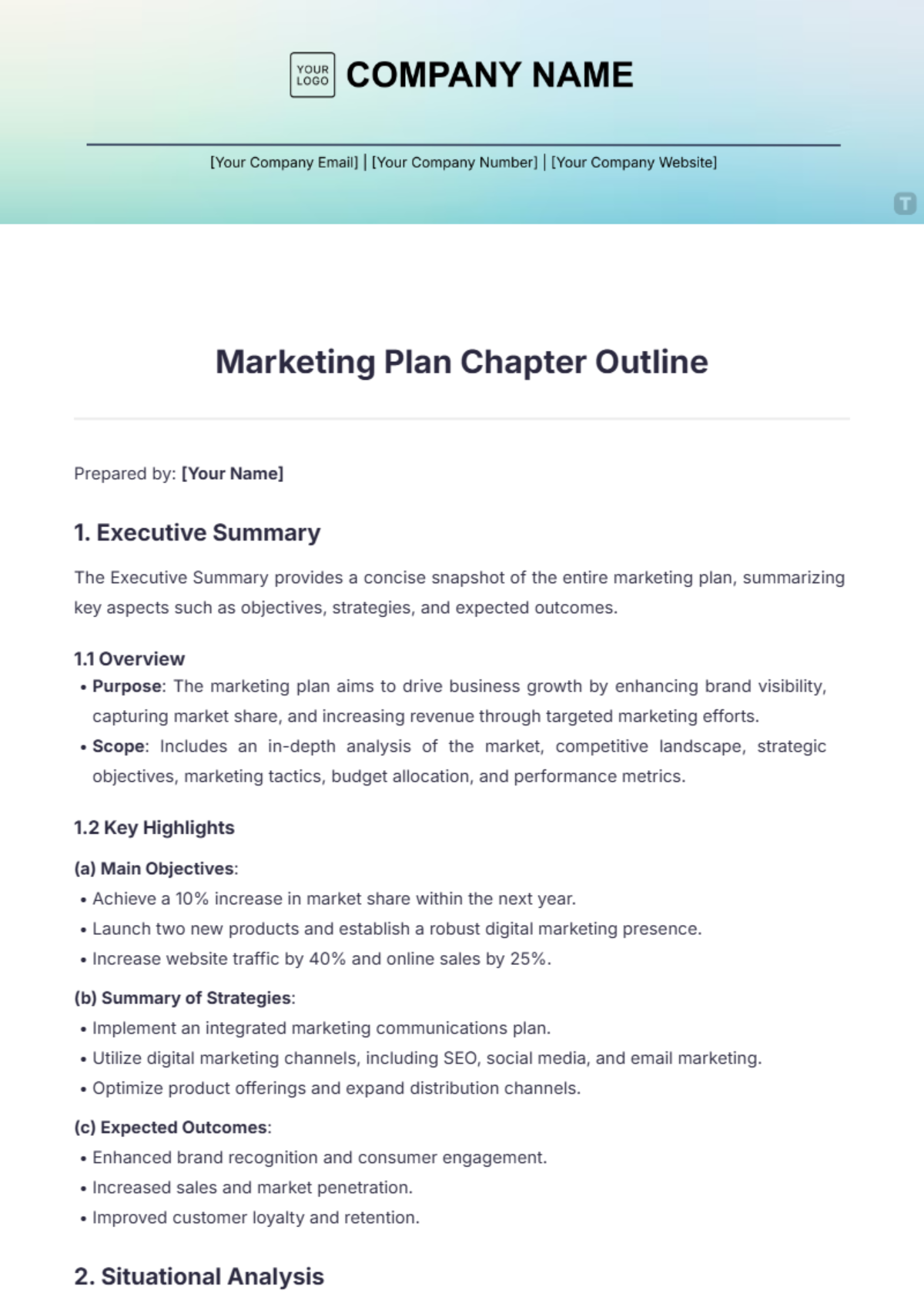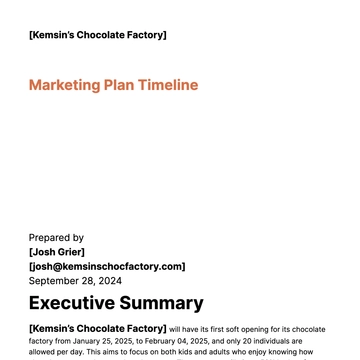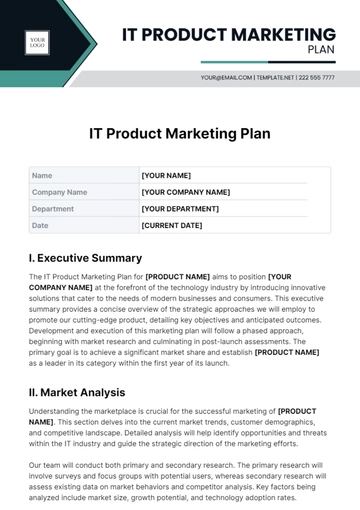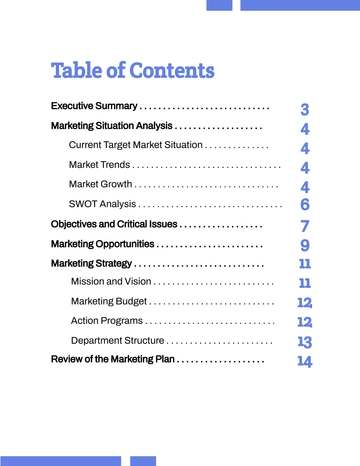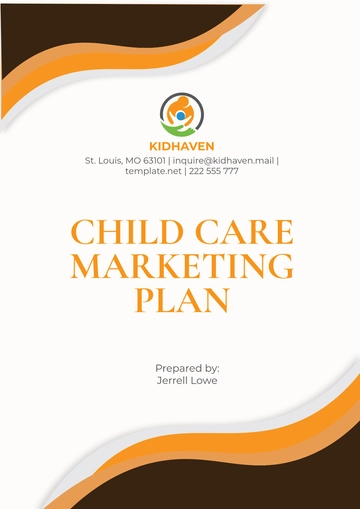Marketing Plan Chapter Outline
Prepared by: [Your Name]
1. Executive Summary
The Executive Summary provides a concise snapshot of the entire marketing plan, summarizing key aspects such as objectives, strategies, and expected outcomes.
1.1 Overview
Purpose: The marketing plan aims to drive business growth by enhancing brand visibility, capturing market share, and increasing revenue through targeted marketing efforts.
Scope: Includes an in-depth analysis of the market, competitive landscape, strategic objectives, marketing tactics, budget allocation, and performance metrics.
1.2 Key Highlights
(a) Main Objectives:
Achieve a 10% increase in market share within the next year.
Launch two new products and establish a robust digital marketing presence.
Increase website traffic by 40% and online sales by 25%.
(b) Summary of Strategies:
Implement an integrated marketing communications plan.
Utilize digital marketing channels, including SEO, social media, and email marketing.
Optimize product offerings and expand distribution channels.
(c) Expected Outcomes:
Enhanced brand recognition and consumer engagement.
Increased sales and market penetration.
Improved customer loyalty and retention.
2. Situational Analysis
2.1 Market Overview
(a) Current Market:
The market is valued at approximately $10 billion, with a projected annual growth rate of 8%.
Key drivers include rising consumer demand for innovative and high-quality products.
(b) Growth Potential:
(c) Market Trends:
Growing preference for eco-friendly products.
Increasing importance of digital channels for consumer engagement.
Rapid technological advancements influencing product innovation.
2.2 Industry Analysis
Industry Overview: The industry is dynamic and competitive, characterized by rapid technological changes and evolving consumer behaviors.
Competitive Landscape: Major competitors include established firms with significant market share and new entrants offering innovative solutions.
Key Players: Industry leaders include companies with strong brand recognition and extensive distribution networks.
2.3 SWOT Analysis
(a) Strengths:
(b) Weaknesses:
(c) Opportunities:
(d) Threats:
2.4 Customer Analysis
(a) Target Segments:
(b) Customer Profiles:
Young Professionals: Tech-savvy, environmentally conscious, and seeking high-quality, innovative products.
Families: Budget-conscious, prioritize practicality and durability, and value family-friendly features.
2.5 Competitor Analysis
Competitor X: Known for competitive pricing and strong online presence. Focuses on high-volume sales and promotional tactics.
Competitor Y: Recognized for innovative product features and premium pricing. Emphasizes brand loyalty and superior customer service.
Analysis: Competitor X’s pricing strategy challenges our positioning, while Competitor Y’s innovation drives us to enhance our product offerings.
3. Marketing Objectives
3.1 Short-term Goals
3.2 Long-term Goals
4. Marketing Strategies
4.1 Target Market Strategy
Segmentation: Segment the market based on demographics, psychographics, and purchasing behavior to identify high-potential customer groups.
Targeting: Focus marketing efforts on high-value segments with tailored messages and offers.
4.2 Positioning Strategy
4.3 Product Strategy
Product Offerings: Introduce new products that cater to emerging consumer needs and preferences. Highlight unique features and benefits.
Product Development: Invest in research and development to create cutting-edge products and enhance existing offerings.
4.4 Pricing Strategy
Pricing Approach: Employ a value-based pricing strategy that reflects the premium quality of the products while remaining competitive in the market.
Pricing Tactics: Implement introductory discounts, bundle deals, and seasonal promotions to attract and retain customers.
4.5 Distribution Strategy
Channels: Utilize a mix of online platforms, retail partnerships, and direct sales to maximize product availability and reach.
Logistics: Optimize supply chain processes to ensure timely and cost-effective delivery of products.
4.6 Promotion Strategy
Promotional Tactics: Develop and execute targeted advertising campaigns, engage in public relations activities, and participate in industry events.
Campaign Focus: Emphasize product benefits, customer testimonials, and brand values.
5. Marketing Tactics and Action Plan
5.1 Product Launch Plan
Launch Schedule: Plan a series of pre-launch activities, including product teasers, media outreach, and influencer partnerships.
Preparation: Create promotional materials, train sales teams, and coordinate logistics for a successful product launch.
5.2 Advertising Plan
Advertising Platforms: Allocate budget to digital advertising (e.g., Google Ads, social media ads), print media, and targeted TV/radio spots.
Budget: Allocate $200,000 for advertising efforts, with specific amounts assigned to each platform and campaign.
5.3 Content Marketing Plan
Content Creation: Develop a content calendar featuring blog posts, videos, infographics, and case studies that align with marketing objectives.
Distribution: Share content across owned media (website, email newsletters), social media platforms, and through partnerships with industry publications.
5.4 Social Media Plan
Platforms: Focus on major social media platforms such as Facebook, Instagram, LinkedIn, and Twitter.
Strategies: Utilize engagement tactics such as interactive posts, contests, and live events to build a community and drive engagement.
Content Schedule: Plan and schedule regular posts to maintain an active and engaging social media presence.
5.5 Sales Strategy
Sales Methods: Implement a multi-channel sales approach, including e-commerce, retail partnerships, and direct sales teams.
Team Structure: Expand the sales team, provide ongoing training, and set clear performance targets to drive sales success.
Sales Targets: Set quarterly and annual sales targets aligned with overall marketing and business goals.
6. Budget and Financial Projections
6.1 Marketing Budget
6.2 Sales Forecast
6.3 ROI Analysis
7. Performance Metrics and Monitoring
7.1 KPIs
Sales Metrics: Track revenue growth, market share, and sales volume.
Marketing Metrics: Measure website traffic, conversion rates, and social media engagement.
Customer Metrics: Monitor customer satisfaction, retention rates, and net promoter score (NPS).
7.2 Monitoring Tools
Tools and Software: Utilize tools such as Google Analytics, social media management platforms, and CRM systems to track and analyze performance.
Purpose: Ensure accurate tracking of marketing activities and effective performance analysis.
7.3 Reporting Schedule
Regular Reports: Prepare monthly and quarterly reports to review marketing performance, assess progress toward goals, and make necessary adjustments.
Review Meetings: Schedule meetings to discuss performance reports, address challenges, and refine strategies.
8. Conclusion
8.1 Summary
Key Elements: Recap the main components of the marketing plan, including objectives, strategies, and expected outcomes.
Commitment: Reinforce the commitment to executing the plan effectively and achieving the outlined goals.
8.2 Next Steps
Action Plan: Outline immediate steps for implementing the marketing plan and initiating key activities.
Ongoing Review: Emphasize the importance of continuous monitoring and adjustments based on performance results.
Chapter Outline Templates @ Template.net
